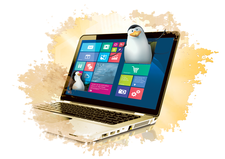Windows 8.1 in VMware and VirtualBox
Virtual Duel

For occasional Windows users, a virtual machine is the ideal solution. But will Windows 8.1 work in VirtualBox and VMware?
Life without Windows just doesn't work for many users. Some tools simply don't have a Linux equivalent, and other situations require Windows for compatibility with co-workers or clients. One easy solution is to run Windows applications directly on Linux using the Wine API. However, Wine doesn't support all versions of all programs. Another alternative is to dual boot, but a dual-boot configuration requires you to restart your computer whenever you want to switch systems.
The most popular alternative on today's networks is to run Windows in a virtual machine on a Linux host. VM technology is so mature that, in normal use, it is difficult to tell the difference between Windows on a virtual machine and on a physical system. (One exception is gaming, which tends to work better without virtualization.)
The biggest players in the market for Windows desktop virtualization on Linux are VirtualBox [1] and VMware Workstation [2]. I took a look at how these leading virtualization alternatives work with the latest Windows.
[...]
Buy this article as PDF
(incl. VAT)
Buy Linux Magazine
Subscribe to our Linux Newsletters
Find Linux and Open Source Jobs
Subscribe to our ADMIN Newsletters
Support Our Work
Linux Magazine content is made possible with support from readers like you. Please consider contributing when you’ve found an article to be beneficial.

News
-
Linux Mint 22.3 Now Available with New Tools
Linux Mint 22.3 has been released with a pair of new tools for system admins and some pretty cool new features.
-
New Linux Malware Targets Cloud-Based Linux Installations
VoidLink, a new Linux malware, should be of real concern because of its stealth and customization.
-
Say Goodbye to Middle-Mouse Paste
Both Gnome and Firefox have proposed getting rid of a long-time favorite Linux feature.
-
Manjaro 26.0 Primary Desktop Environments Default to Wayland
If you want to stick with X.Org, you'll be limited to the desktop environments you can choose.
-
Mozilla Plans to AI-ify Firefox
With a new CEO in control, Mozilla is doubling down on a strategy of trust, all the while leaning into AI.
-
Gnome Says No to AI-Generated Extensions
If you're a developer wanting to create a new Gnome extension, you'd best set aside that AI code generator, because the extension team will have none of that.
-
Parrot OS Switches to KDE Plasma Desktop
Yet another distro is making the move to the KDE Plasma desktop.
-
TUXEDO Announces Gemini 17
TUXEDO Computers has released the fourth generation of its Gemini laptop with plenty of updates.
-
Two New Distros Adopt Enlightenment
MX Moksha and AV Linux 25 join ranks with Bodhi Linux and embrace the Enlightenment desktop.
-
Solus Linux 4.8 Removes Python 2
Solus Linux 4.8 has been released with the latest Linux kernel, updated desktops, and a key removal.

